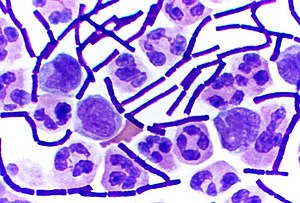71.98.180.114 (talk) →Characteristics: capitalization |
Gene Nygaard (talk | contribs) capitalization |
||
| Line 1: | Line 1: | ||
[[Image:Gram_Stain_Anthrax.jpg|thumb|right|300px|Gram-positive [[anthrax disease|anthrax]] bacteria (purple rods) in [[cerebrospinal fluid]] sample. The other cells are [[white blood cell]]s]] |
[[Image:Gram_Stain_Anthrax.jpg|thumb|right|300px|Gram-positive [[anthrax disease|anthrax]] bacteria (purple rods) in [[cerebrospinal fluid]] sample. The other cells are [[white blood cell]]s]] |
||
'''Gram-positive''' [[bacteria]] are classified as bacteria that retain a crystal violet dye during the [[ |
'''Gram-positive''' [[bacteria]] are classified as bacteria that retain a crystal violet dye during the [[Gram stain]] process. Gram-positive bacteria will appear blue or violet under a microscope, whereas [[Gram-negative]] bacteria will appear red or pink. The difference in classification is largely based on a difference in the bacteria's cell wall structure. |
||
==Characteristics== |
==Characteristics== |
||
| Line 9: | Line 9: | ||
#[[Teichoic acids]] are present, which serve to act as chelating agents, and also for certain types of adherence |
#[[Teichoic acids]] are present, which serve to act as chelating agents, and also for certain types of adherence |
||
==History of Gram |
==History of Gram positive== |
||
In the original bacterial phyla, the Gram-positive forms made up the [[phylum (biology)|phylum]] [[Firmicutes]], a name now used for the largest group. It includes many well-known genera such as ''[[Bacillus]]'', ''[[Listeria]]'', ''[[Staphylococcus]]'', ''[[Streptococcus]]'', ''[[Enterococcus]]'', and ''[[Clostridium]]''. It has also been expanded to include the Mollicutes, bacteria like ''[[Mycoplasma]]'' that lack cell walls and so cannot be stained by Gram, but are derived from such forms. |
In the original bacterial phyla, the Gram-positive forms made up the [[phylum (biology)|phylum]] [[Firmicutes]], a name now used for the largest group. It includes many well-known genera such as ''[[Bacillus]]'', ''[[Listeria]]'', ''[[Staphylococcus]]'', ''[[Streptococcus]]'', ''[[Enterococcus]]'', and ''[[Clostridium]]''. It has also been expanded to include the Mollicutes, bacteria like ''[[Mycoplasma]]'' that lack cell walls and so cannot be stained by Gram, but are derived from such forms. |
||
Revision as of 15:47, 25 September 2006

Gram-positive bacteria are classified as bacteria that retain a crystal violet dye during the Gram stain process. Gram-positive bacteria will appear blue or violet under a microscope, whereas Gram-negative bacteria will appear red or pink. The difference in classification is largely based on a difference in the bacteria's cell wall structure.
Characteristics
The following characteristics are generally present in a Gram-positive bacteria:
- A very thick cell wall (peptidoglycan)
- If a flagella is present, it contains two rings for support (an additional two rings are not necessary, unlike in Gram-negative bacteria, because the thick cell wall is supportive enough)
- Teichoic acids are present, which serve to act as chelating agents, and also for certain types of adherence
History of Gram positive
In the original bacterial phyla, the Gram-positive forms made up the phylum Firmicutes, a name now used for the largest group. It includes many well-known genera such as Bacillus, Listeria, Staphylococcus, Streptococcus, Enterococcus, and Clostridium. It has also been expanded to include the Mollicutes, bacteria like Mycoplasma that lack cell walls and so cannot be stained by Gram, but are derived from such forms.
The actinobacteria are another major group of Gram-positive bacteria; they and the Firmicutes are referred to as the high and low G+C groups based on the guanosine and cytosine content of their DNA. If the second membrane is a derived condition, the two may have been basal among the bacteria; otherwise they are probably a relatively recent monophyletic group. They have been considered as possible ancestors for the archaeans and eukaryotes, both because they are unusual in lacking the second membrane and because of various biochemical similarities such as the presence of sterols.
The Deinococcus-Thermus bacteria also have Gram-positive stains, although they are structurally similar to Gram-negative bacteria.
Both Gram-positive and Gram-negative bacteria may have a membrane called an S-layer. In Gram-negative bacteria, the S-layer is directly attached to the outer membrane. In Gram-positive bacteria, the S-layer is attached to the peptidoglycan layer. Unique to Gram-positive bacteria is the presence of teichoic acids in the cell wall. Some particular teichoic acids, lipoteichoic acids, have a lipid component and can assist in anchoring peptidoglycan, as the lipid component is embedded in the membrane.
See also
References
- Baron, Samuel (1996). Medical Microbiology (4th ed. ed.). The University of Texas Medical Branch at Galveston. ISBN 0-9631172-1-1.
{{cite book}}:|edition=has extra text (help) - Madigan, Michael; Martinko, John (editors) (2005). Brock Biology of Microorganisms (11th ed. ed.). Prentice Hall. ISBN 0-13-144329-1.
{{cite book}}:|author=has generic name (help);|edition=has extra text (help)CS1 maint: multiple names: authors list (link)  This article incorporates public domain material from Science Primer. NCBI. Archived from the original on 2009-12-08.
This article incorporates public domain material from Science Primer. NCBI. Archived from the original on 2009-12-08.